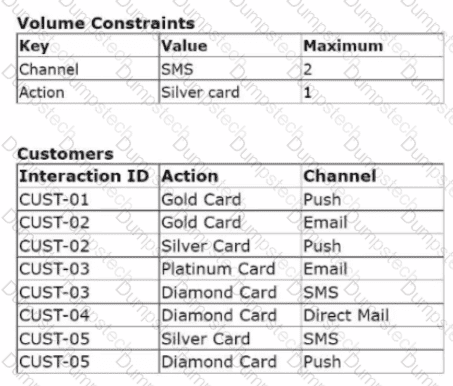New Year Sale Limited Time 70% Discount Offer - Ends in 0d 00h 00m 00s - Coupon code = simple70
Pass the Pegasystems Pega Decisioning Consultant PEGACPDC25V1 Questions and answers with Dumpstech
MyCo, a telecom company, recently introduced a new mobile handset offer, MyFone 14 Pro, for its premium customers. As the bank has financial targets to meet, the business decides to boost the MyFone 14 Pro offer.
As a decisioning architect, how can you ensure that the MyFone 14 Pro offer is prioritized over other offers?
An outbound run identifies 150 Standard card offers, 75 on email, and 75 on the SMS channel. If the following volume constraint Is applied, how many actions are delivered by the outbound run?

A financial institution has created a new policy that states the company will not send more than 500 emails per day. Which option allows you to implement the requirement?
A financial services company has implemented always-on outbound campaigns for three credit card offers: Standard card. Rewards card, and Rewards Plus card. The marketing team observes that customers who are qualified for multiple actions receive different numbers of offers, depending on the configuration of the volume constraint mode. To optimize customer engagement, the system administrator must choose between constraint modes.
Which volume constraint mode ensures that customers receive all actions for which they qualify, provided the actions do not reach volume limits?
As a Customer Service Representative, you present an offer to a customer who called to learn more about a new product. The customer rejects the offer. What is the next step that Pega Customer Decision Hub takes?
A volume constraint uses the Return any action that does not exceed
constraint mode. The following tables show the configuration of the volume constraints and the list of customers in the outbound segment:

The outbound run selects customers in the following order to apply the volume constraints: CUST-01, CUST-02, CUST-03, and CUST-05.
Based on the configuration of the volume constraints for each channel, which offer does CUST-05 receive?
U+ Bank, a retail bank, is designing an engagement policy for its credit card promotions. To meet legal requirements, the bank must ensure that only customers aged 18 or older are considered for any credit card offer.
Which policy configuration level should U+ Bank use to implement the age requirement (18+ years) for all credit card promotions?
In a decision strategy, you can use aggregation components to____________.
U+ Bank, a retail bank, uses the business operations environment to perform its business changes. The bank completes these changes by using revision management features of Pega Customer Decision Hub™ and 1:1 Operations Manager.
Customers see credit card offers based on various engagement policies on the U+ Bank website. The bank wants to update the underlying decision strategy of
an engagement policy condition.
According to best practices, which statement correctly describes the implementation of the change to fulfill this business requirement?
As a decisioning architect, how can you optimize the strategies that are based on Insights that you gain from the AI Insight feature in the Customer Profile Viewer?
